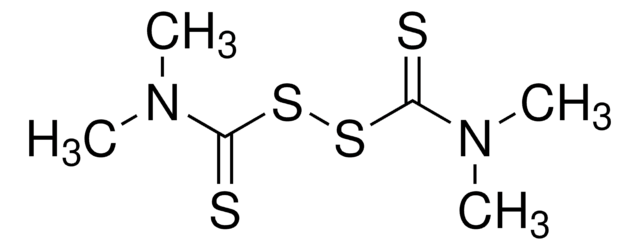13825
Sulfur
powder, ≥99.0%
Autenticatiper visualizzare i prezzi riservati alla tua organizzazione & contrattuali
About This Item
Formula empirica (notazione di Hill):
S
Numero CAS:
Peso molecolare:
32.07
Numero MDL:
Codice UNSPSC:
12141912
ID PubChem:
NACRES:
NA.55
Saggio:
≥99.0%
Stato:
powder
Prodotti consigliati
Densità del vapore
8.9 (vs air)
Livello qualitativo
Tensione di vapore
1 mmHg ( 183.8 °C)
10 mmHg ( 246 °C)
Saggio
≥99.0%
Stato
powder
Temp. autoaccensione
450 °F
Resistività
2E23 μΩ-cm, 20°C
Ceneri
≤3%
pH
6 (20 °C, 10 g/L)
P. ebollizione
444.7 °C (lit.)
Punto di fusione
112.8 °C (rhombic) (lit.)
117-120 °C (lit.)
119.0 °C (monoclinic) (lit.)
Stringa SMILE
[S]
InChI
1S/S
NINIDFKCEFEMDL-UHFFFAOYSA-N
Cerchi prodotti simili? Visita Guida al confronto tra prodotti
Descrizione generale
Sulfur is present in abundant quantities in marine and freshwater sediments. It exists in the form of various sulfur compounds such as pyrite, acid volatile sulfides, elemental sulfur, sulfates and organic sulfur. Quantitative estimation of reduced inorganic sulfur compounds in modern sediments and shales by a chromium reduction technique has been described.
Sulfur is naturally present in cysteine and methionine amino acids, which can be detected by inductively coupled plasma mass spectrometry(ICP-MS). It is also an important element required for plant growth, since it is useful in lowering the pH of the soil.
Sulfur is naturally present in cysteine and methionine amino acids, which can be detected by inductively coupled plasma mass spectrometry(ICP-MS). It is also an important element required for plant growth, since it is useful in lowering the pH of the soil.
Avvertenze
Warning
Indicazioni di pericolo
Consigli di prudenza
Classi di pericolo
Skin Irrit. 2
Codice della classe di stoccaggio
4.1B - Flammable solid hazardous materials
Classe di pericolosità dell'acqua (WGK)
WGK 1
Punto d’infiammabilità (°F)
404.6 °F - closed cup
Punto d’infiammabilità (°C)
207 °C - closed cup
Scegli una delle versioni più recenti:
Possiedi già questo prodotto?
I documenti relativi ai prodotti acquistati recentemente sono disponibili nell’Archivio dei documenti.
I clienti hanno visto anche
Mccarty.B.L et al.
Fundamentals of Turfgrass and Agricultural Chemistry (2003)
Sulfur as the key element for quantitative protein analysis by capillary liquid chromatography coupled to element mass spectrometry
Wind M, et al.
Angewandte Chemie (International Edition in English), 42(29)x`, 3425-3427 (2003)
A Scotto Rosato et al.
Nature communications, 10(1), 5630-5630 (2019-12-12)
The lysosomal calcium channel TRPML1, whose mutations cause the lysosomal storage disorder (LSD) mucolipidosis type IV (MLIV), contributes to upregulate autophagic genes by inducing the nuclear translocation of the transcription factor EB (TFEB). Here we show that TRPML1 activation also
Il team dei nostri ricercatori vanta grande esperienza in tutte le aree della ricerca quali Life Science, scienza dei materiali, sintesi chimica, cromatografia, discipline analitiche, ecc..
Contatta l'Assistenza Tecnica.
![2-{2-[(2-Bromo-6-chlorophenyl)amino]phenyl}acetic acid pharmaceutical impurity standard](/deepweb/assets/sigmaaldrich/product/structures/303/197/4983f71e-abfb-4dc7-b1e9-0446b7f2c476/640/4983f71e-abfb-4dc7-b1e9-0446b7f2c476.png)





